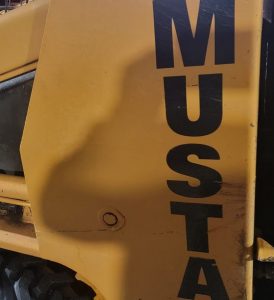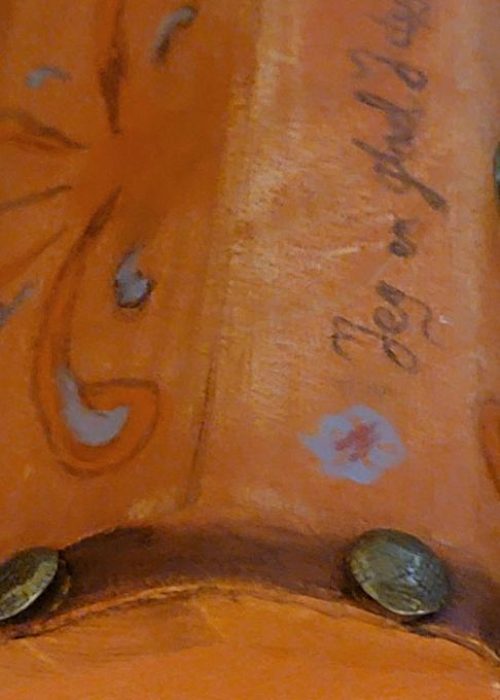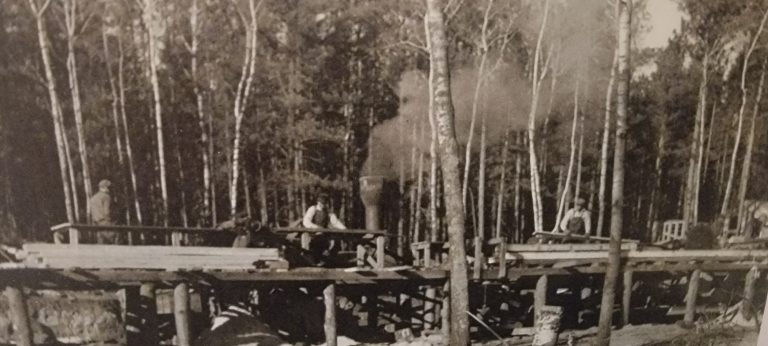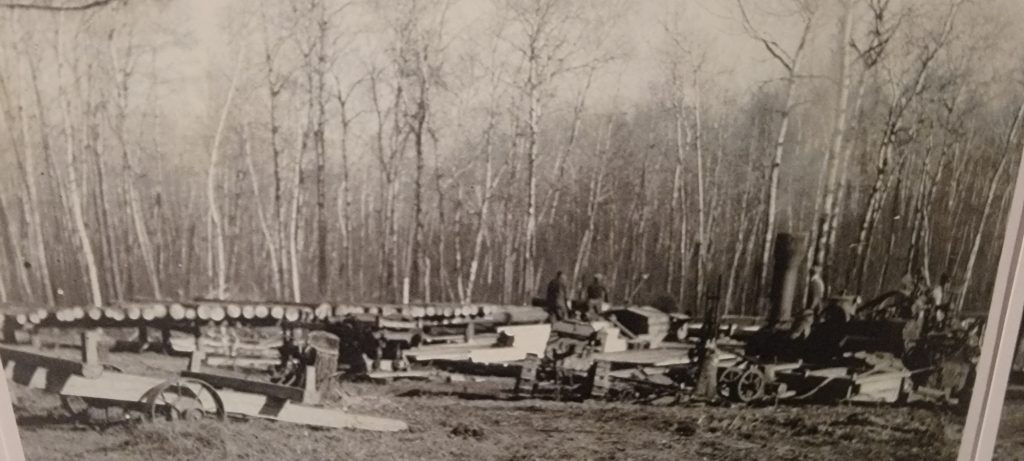Har du røyka sokka dine?
Have you smoked your socks? – Google translate Norwegian to English
The day I “smoked my socks” was magical, or delusional – you decide.
That April day to prepare for the May opening at Evergreen Bay Resort. A late, wet and cold spring put off everything. Cabins to clean and water and furnaces start. The beach needs leveling, docks to roll out and the Adirondack loungers were still in storage. Spring grounds keeping was the worst. The grounds were ankle deep pine needles. But today would be improving a few miles of trails in our 60 acres of Minnesota forest. Working in these woods is special. Always something new to see.
I topped off the old Mustang skid steer with diesel. Like always it started right away. In a few minutes I was on one of the trails. They are generally clear. But broken branches and dead brush encroached the trails due to the winter shed and last season’s growth. The work is not challenging. After 30 minutes it becomes boring and mindless even in this old growth forest.
My thoughts drifted to my youth. Splendid summers spent at Skogfjorden, the Concordia Norwegian Language village near Bemidji, MN. I’m half German but Dad wanted me to learn the language and culture of “my better half”, Norwegian.
The language is amazing. Its filled with colorful allusions and sayings. We all know “Uff da”. It translates to “oops then”, but can mean so much more. And “Å Kjøpe Katta I Sekken” which translates to “buying a cat in the bag” and meaning “you made a terrible buy”. Its easy to love the Norsk culture too, rich in history, art, mythology and humor.
I miss my Dad. He would have loved this place. Thank you Dad for my camp memories. They are a perfect distraction for the monotony of running the skid steer down these trails…
…morning flag raising, eating brown goat cheese and flatbread for breakfast and afternoon outdoor Norsk language classes…
Noticing an uneven patch ahead, I steered to the spot. Level the grade, fill the dip and continue down the trail…
…swimming in Turtle Lake, leeches, campfire gatherings, canoeing, soccer, the camp shop with Norwegian chocolates, pewter gifts, foreign pop music on the speaker…
I need to knock down that dead overhanging oak branch, clear more brush and push it off the trail. Done. Now a sharp corner and onto a more dense path running along the frog pond…
…learning a folk song about a hungry bird, rosemaling and wood carving class, stories of Odin, trolls and other Norse spirits…
The trail is too narrow here. I scrap out a thicket by the roots, push it aside and see an old hollow tree leaning toward the trail. It’s got to go. So, bucket up! Push and over it goes! I love the sight, sounds and smells of a rotten tree trunk falling.
The roots crack. As the truck starts to tip, it flushes a fast rabbit. I see and a blur of brown, white and…red? It zips into the brush. More roots erupt and I can smell rich earth as the old and once mighty tree falls. With a deep thump the rotted trunk burst wide open spilling debris beside the trail. I assumed the debris was a new find of an old dump.
This property has history. It’s been a resort since the early fifties. Before that -in the 30’s, it was the Boot Lake Saw Mill. Back then burying trash was the norm. So unfortunately, I have had to clean up a couple garbage dumps. More old bottles, tin cans and Bakelite.
I shut down the skid steer, grab a garbage bag and jump off. Within a few steps It was obvious this wasn’t from an old dump. Instead of garbage there was an assortment of odd little things. I pick up a miniature wooden cargo trunk. Covered with faded brown paint, rosemaling and “Jeg er glad I deg” scrolled above the latch. There was more writing on the trunk. It had some weight and something was inside.
I put this little treasure in my jacket pocket to explore later.
Next, I found old worn cloth and stuffed wool socks near a wood frame. More debris. A used birthday cake candles, a broken doll house table and chairs, a broken single pane glass lay there. Strange garbage?
I followed the debris pile across the rotted pine trunk. I picked up tiny twigs bundled together with fine wire, small wood cups? Small dime-sized disks, could these be plates? There is a tiny milk glass kerosene lamp, scorched from use and a red vintage oiler can. That’s odd. The oiler had been on cut open on the side and there were glowing embers inside! Near the spout was a long, charred copper tube with a wisp of smoke coming out the end. A fireplace? This was no garbage dump, but what was it! Such wild thoughts were popping into my mind. Something was living in that tree!
Then I remembered a saying from camp. When a Norwegian wonders if you are crazy, they ask “Har du røyka sokka dine?”
Yep – Crazy. I had “smoked my socks”!
Jeg har en høne
å plukke med deg.
I have a hen to pluck with you. Meaning I have a bone to pick with you.


My imagination was in overdrive, as I drove back to the resort’s garage. I backed in and in my rearview mirror was that same rabbit. This time I saw that blur of brown, white and red on top of the rabbit. Something riding a rabbit? That was too much crazy for one day. So I put that thought away, parked the skid steer and hopped out. I emptied the bag onto my workbench.
I examined the kerosene lamp, first. The wick was wet and it smelled – oily. There was liquid in the reservoir and my shelf with stick matches close by. The wick lit and I covered it with the milk glass chimney. The soft glow from this well used lamp was not bright. But it was perfect to light inside a hollow tree home.
Everything else on the bench began to make sense. The bundled sticks were fuel for the oiler can fireplace. I even found a small metal rod that used to stoke the fire. The sock stuffed with cat tail seed and fit into the wood frame. Along with the aged felt and wool cloth I am sure it was a bed. Other pieces of cloth fashioned into doll size clothing. Simple tops and pants and a heavy winter cloak.
Then, I remember the cargo trunk and pulled it from my pocket. How beautiful. Simple folk art rosemaling and more writing. Vatland and Sokndal on the sides with Rogaland, Norge on the back. Like a child, I shook the trunk and heard something hard inside. I opened it to see an aged clipping from the Minneapolis Tidende Juni 1919, with more Norsk writings. A folded piece of corded silk rested below the clippings and above the coin. It was a one Krone silver coin, dated 1885. It wasn’t in great shape but was the same year my grandfather was born. I slipped the coin into my pocket.
Then an acorn dropped onto the work bench. A squirrel nest in the rafters? That would have to wait. My focused returned to the items. A second acorn bounce near me, and I heard a voice. It sounded like “Steven.” Startled I look to the door thinking someone had stopped by. Nothing. I was imagining sounds now.
Another acorn and then from the rafters, and in a deep accented voice I heard, “Tyven!, Tyven! Tyven!”
Goosebumps popped and the back of my neck tingled. I turned and looked up to see an small two-legged creature standing on a rafter. It chucked another acorn that missed by a mile. In disbelief I stared at a small white-bearded, acorn chucking, Lorax like creature. Topped with a red and white knit cap. Below the cap are a set of glaring, glittering, metallic-gold eyes. A bulbous round nose. Long thick white whiskers covered his face and drapped to his waist.
Black boots, filthy light-colored trousers and a brown finished the Nordic costume. More clothing like that laid on my work bench. He looked angry. He cocked his left arm ready to hurl another acorn.
“Wait!” Dumbfounded, I stammered, “My name is not Steven. It’s Bill.”
The creature cocked his head, and with a head shake said, “Å være pling i bollen!”
I recognized that! Well some of it. My Norwegian has rusted over the years. But I understood it to be something to do with a bowl. I later learned that it was calling me an idiot.
He fired his acorn, missed again and repeated. “Tyven!” Tyven was Norwegian for thief and in my defense does rhyme with Steven. Louder and clearer the creature continued in Norwegian.
“Kulturminne stjålet fra husen mitt!” Words clicked again! I understood. “Something stolen-house-mine.” No idea what the first word meant.
I uttered “Unnskyld.” An apology of sorts. Wait, it meant pardon me, but I was sincere and it was a good attempt considering my language limitations.
It seemed to appreciate my attempt. Less agitated, it moved closer, but kept the acorn at the ready. He slowed his speech.
“Du brøt huset mitt.” “Broke-house-mine”
“Jeg vis ha mine.” “I want things.”
Doubt flooded my senses. I was looking into the eyes of a talking, walking mystical creature! I knew it defied reason, but I also knew this was happening, so with sincerity and interest I bumbled out,
“Unnskyld.” “Pardon”, then I remembered “Beklager” “I’m Sorry”
“Hva heter du?” “What’s your name?”
“Er du Troll?” “Are you a Troll?”
“Snakke englesk?” “Do you speak English?”
Lowering his acorn, the fellow peered down at me and said in accented english, “Small English.” Then pointed to his chest. “No troll. “Jeg er en NISSE.” The acorn lowered and the Nisse sat. I sensed sadness when he said “Jeg sier ikke navnet. Navn for familien min”. I understood that to mean “I say not name. Name only for my family.”
It was magical! We were conversing! Clumsy and slow, but an enlightening, real conversation. With caution, I pulled out my phone, opened an app, typed, and said “Oversette” “Translate”. We gained momentum in our exchange, and we spent the rest of that afternoon learning about each other.
Kulturminne
Cultural Memory

Our conversation was one-sided since I needed my phone to translate. It was clear that the Nisse wanted to talk. He grew comfortable. Moving closer, he jumped to the far end of the workbench. Settling on top of my rolling tool box and closer to the open garage door.
The rest of our afternoon was tantalizing. I learned the magical Nisses live for “Århundrer” “centuries”. They are wise, fun loving, secretive, loyal and very mischievous. Nisses bond with human families. They watch over their homes, farms, shops, forests, ships, or other “tall people” endeavors. Nisses are guardians for their families and protect them from bad spirits.
Always treat Nisse’s with love, kindness and respect. If not, they’ll cause trouble. It’s a blessing to have a Nisse join a family.
In 1919, he traveled to America with a member of his Norwegian family. Soon after immigrating they lost each other on the east coast. For years, he searched for his family but with no luck. He befriended a good-hearted Swedish lumberjack. The Swede came to America to “Conquer a great forest and marry an Indian maiden!” The two shared many adventures, ending at the Boot Lake Saw Mill, north of Park Rapids, Minnesota. That’s a story for another time.
He came to this “marka” “a forest with trails” as a 62 year old, quite young for a Nisse to travel. When the Nisse and the Swede traveled together, they fell in love with America and with Minnesota. The beautiful forest that lay along crystal-clear Boot Lake became their home. The Nisse watch over the forest and it’s animals, even the deer. The property was a sawmill and became a resort in the 1950’s. The spirit of the Swede and the Nisse watched over this magical place.
The Nisse had built his home in the forest near the Mill. The same home I destroyed earlier. He talked of his many forest friends, including the rabbit he rode. He pointed down. I notice a rabbit hidden by the wheel of my rolling tool box. He told me the rabbit’s name is “Rabarbra” “Rhubarb” in english.
He directed a sarcastic comment more to Rhubarb than me. “On VERY special occasions, Rabarbra honors me with a ride through the forest”. I don’t think rabbits can roll their eyes, but that is the feeling I sensed from it. The rabbit snorted loud enough for us both to hear, than stomped his rear foot once. He moved closer to the open garage door so he could better ignore us.
The Nisse explained. Even after the Swede left the mill, he stayed around Evergreen Bay because it is a special place. He had many friends here, loved watching guest come during the summer, and he had a home; but no family. With his home gone, it was time to gather his “Kulturminne” to try again to find his family.
I asked, “What is Kulturminne?” He explained it a “special visible trace to one’s past.”


Å være midt i smørøyet
To be in the middle of the butter eye
In my final minutes with the Nisse, I apologized again for destroying his house. Then thanked him you for sharing his story with me.”
He paused. Then told me, “I talk to you because you are like the lumberjack”
I was the first “høye folk” or “tall person” he had spoken with since the Swede. He had watched me since I bought the resort four years ago. According to the Nisse, the Swede and I have “Filuftsliv” “a love of the outdoors”. He said we follow the proverb “Berre den som vandrar, finn nye vegar.” which translates to “Only those who wander find new paths.”
He also let me know that I often, “Der er ugler i mosen”, “I put owls in the moss.” Meaning “Do mysterious or strange things”. It happens because he told me, “You were born behind a brown cheese” meaning, “I am not smart.” He was kidding. But he wasn’t wrong.
I apologized again, offered to build him another house and asked him to stay.
“You could watch over everyone in the forest and at the Resort.” I added, “Even though Rabarbra can throws acorns better than you, I am sure you could be useful.”
My attempt at humor drew a small chuckle, a sparkle in his eye, and a shake of the head.
He accepted my apologies, but would not stay. Now was the time to gather his “Kulturminne” and continue his search for his family.
Resigned, I asked, “How can I help?”
“Move things tonight. Set there.” pointing to a shelf near the garage door.
“Everything here? Do you want it in a bag?” I wondered.
“Not all. Wooden box with things inside and coin in your pocket is my Kulturminne.”
I had forgotten the coin. I reached into my pocket and pulled it out. I took a chance. “May I keep this? It is Kulturminne to me.”
The Nisse paused and asked “Why Kulturminne for you?”
“My grandfather, William Benjamin Williams, was born in Norway. In 1885 – the year of this coin.”
The Nisse froze and asked. “Si på norsk?” “Say in Norwegian?” now looking at me with great intensity.
“My grandfather was christened, Wilhem, Berntsen Vatland”. His stare was piercing. I stared back. It was becoming uncomfortable.
Then I looked down and noticed the rabbit . Rhubarb had moved closer and was now focused on me and the Nisse.
The Nisse shrugged to Rhubarb, looked back to me, smiled and introduced himself. “Jeg heter Eiketre.” “My name is Eiketre.” (Pronounced Ike a tree) “Vi er familie” “We are family.”
He gave me the coin but it wasn’t a gift. I was to build him a new home at the resort. The coin was my payment. It turns out my grandfather had given him the coin before the left Norway, in 1919.
Looking satisfied, Eiketre moved very close and said, “Å være midt i smørøyet”. Another unique saying that translates to “be in middle of the butter eye”. Norwegians love their warm porridge. It’s served with generous helping of sugar and cinnamon. A large pat of melting butter right in the middle being the best part. It means “To be in a great place.”
Rhubarb came close too. Eiketre jumped on his back. They bolted out the garage door and turned toward the 60-acre wood.
Believe or not, that’s how Eiketre, became the forest spirit or Skogsånd of Evergreen Bay Resort.
When staying at the resort, you will never see him, but you can check out his house located near the lodge. He won’t talk to you -unless your related, but you can ask him a question. He MAY respond. It MUST have your name, the cabin you are staying in, and you must write it in English – he’s working on his English. Tape a penny to your question and leave the note in his shed, beside his house. IF he responds, he delivers them to me in a sealed envelope.
When hiking the forest and if you are very observant you might see signs of Eiketre the Nisse. Look for markings on trees, rocks and in the woods. I am pretty sure in you’ll see some of his forest friends. If you have sharp eyes, you might even recognize Rhubarb the Rabbit.
The End.
In my final minutes with the Nisse, I apologized again for destroying his house. Then thanked him you for sharing his story with me.”
He paused. Then told me, “I talk to you because you are like the lumberjack”
I was the first “høye folk” or “tall person” he had spoken with since the Swede. He had watched me since I bought the resort four years ago. According to the Nisse, the Swede and I have “Filuftsliv” “a love of the outdoors”. He said we follow the proverb “Berre den som vandrar, finn nye vegar.” which translates to “Only those who wander find new paths.”
He also let me know that I often, “Der er ugler i mosen”, “I put owls in the moss.” Meaning “Do mysterious or strange things”. It happens because he told me, “You were born behind a brown cheese” meaning, “I am not smart.” He was kidding. But he wasn’t wrong.
I apologized again, offered to build him another house and asked him to stay.
“You could watch over everyone in the forest and at the Resort.” I added, “Even though Rabarbra can throws acorns better than you, I am sure you could be useful.”
My attempt at humor drew a small chuckle, a sparkle in his eye, and a shake of the head.
He accepted my apologies, but would not stay. Now was the time to gather his “Kulturminne” and continue his search for his family.
Resigned, I asked, “How can I help?”
“Move things tonight. Set there.” pointing to a shelf near the garage door.
“Everything here? Do you want it in a bag?” I wondered.
“Not all. Wooden box with things inside and coin in your pocket is my Kulturminne.”
I had forgotten the coin. I reached into my pocket and pulled it out. I took a chance. “May I keep this? It is Kulturminne to me.”
The Nisse paused and asked “Why Kulturminne for you?”
“My grandfather, William Benjamin Williams, was born in Norway. In 1885 – the year of this coin.”
The Nisse froze and asked. “Si på norsk?” “Say in Norwegian?” now looking at me with great intensity.
“My grandfather was christened, Wilhem, Berntsen Vatland”. His stare was piercing. I stared back. It was becoming uncomfortable.
Then I looked down and noticed the rabbit . Rhubarb had moved closer and was now focused on me and the Nisse.
The Nisse shrugged to Rhubarb, looked back to me, smiled and introduced himself. “Jeg heter Eiketre.” “My name is Eiketre.” (Pronounced Ike a tree) “Vi er familie” “We are family.”
He gave me the coin but it wasn’t a gift. I was to build him a new home at the resort. The coin was my payment. It turns out my grandfather had given him the coin before the left Norway, in 1919.
Looking satisfied, Eiketre moved very close and said, “Å være midt i smørøyet”. Another unique saying that translates to “be in middle of the butter eye”. Norwegians love their warm porridge. It’s served with generous helping of sugar and cinnamon. A large pat of melting butter right in the middle being the best part. It means “To be in a great place.”
Rhubarb came close too. Eiketre jumped on his back. They bolted out the garage door and turned toward the 60-acre wood.
Believe or not, that’s how Eiketre, became the forest spirit or Skogsånd of Evergreen Bay Resort.
When staying at the resort, you will never see him, but you can check out his house located near the lodge. He won’t talk to you -unless your related, but you can ask him a question. He MAY respond. It MUST have your name, the cabin you are staying in, and you must write it in English – he’s working on his English. Tape a penny to your question and leave the note in his shed, beside his house. IF he responds, he delivers them to me in a sealed envelope.
When hiking the forest and if you are very observant you might see signs of Eiketre the Nisse. Look for markings on trees, rocks and in the woods. I am pretty sure in you’ll see some of his forest friends. If you have sharp eyes, you might even recognize Rhubarb the Rabbit.
The End.


